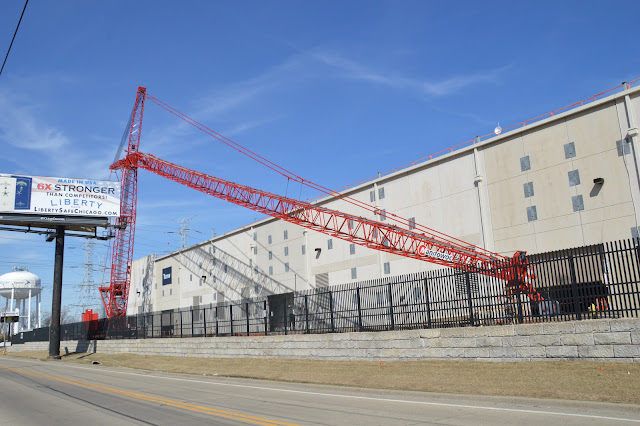I've been seeing some postings of a Manitowoc MLC 300 next to I-294. So on the first clear day of this year that wasn't cold and/or windy, March 26, I made a trip up there to check it out. It is working on a Microsoft building. I got there before 3pm, but they had already stopped working for the day. However, the trip was not in vain because I did want to get photos of the crane with a long luffer jib in its parked (jackknifed) position.
In this post, the operator, Frank Bauer, explains: "we start at 95 main and 255 Lyft then go to 95m and 196 l and finish with 95 m and 177 l."
 |
| 20190328 7454 |
I count ten counterweights on each side for a total weight of 200t. Note the box on top of the right counterweight stack. The toolbox on top of the right counterweight stack "probably holds rigging to put the crane together." [Joseph Hobbs comment on one of my Facebook postings.] Thomas Cassidy The box on top holds the beckets and 2 block weights and stuff like that. Derek Huss That box is a tool box our 300mlc had beckets and some pins in it.
I then walked across Northwest Avenue to get some distance from the crane so that I could get some overview shots. I repeat the photo at the top of these notes to put it in context. I had to move around to find an angle that included the whole crane with my zoom's widest angle of 18mm, to reduce the glare off the boom, and to clear the billboard.
At the other end, I crossed Northwest Avenue again to try to find an overview that was clear of the billboard.
I'm including this "bad" view. Even though the main boom got skunked by the billboard, this angle has a better view of the wheels on the tip that are needed if they want to lower the main boom all the way down to the ground.
 |
| A close up of the tip |
 |
| An even closer view of the tip wheels at camera resolution. I was curious how much detail the camera could capture at ISO 400. |
In this close up, we can see that the hoists are mounted in the base of the boom. This allows the designers of the crane to reduce the weight of the housing so that it is cheaper to transport it over the road. (It is still probably expensive. But it is cheaper than it would be if all of the hoists were still in the house.) We can also see the 300 of the MLC300 label so I know it is not a MLC650.
In this view, I was trying to get most of the hydraulic hoses that power those hoists to show between the fence posts.
With this angle, I'm trying to show the loop in the VPC "chain."
I was going to skip this first closeup photo I took, but now I see that it confirms the purpose of the "chain" is to organize and protect all of the hydraulic hoses that go to the counterweight tray.
It appears they are adding HVAC (Heating, Ventilation, and Air Conditioning) equipment on the roof.
A couple of days after I took my photos, John Schilberg caught it parked at the middle of the building instead of at the north end. One advantage of this job compared to windmill erection is that they are walking the crane on a paved surface rather than on a farmer's field.
 |
| John Schilberg posted |
 |
| Elaine Peterson posted, cropped |
Thomas Cassidy The box on top holds the beckets and 2 block weights and stuff like that.
Derek Huss That box is a tool box our 300mlc had beckets and some pins in it
 |
| Anthony Carney commented on my post |
David Hall posted three photos with the comment: "Seen this little fella by rosemont."
John Craig Weir Not Rosemont in Northlake I believe. 294 North Bound.
John Craig Weir Microsoft Data Center when it was originally built.
 |
| 1 |
 |
| 2 |
 |
| 3 |
While driving east on North Avenue, I discovered that a Manitowoc 2250 luffer crane is helping to build a new building between Foxy Nail and a Shell station.
(End of crane photos.)
Most of my notes that have the "engeryElectric" label are concerned with the generation or transmission of electricity. In this case, it is about the consumption of electricity. There are no signs on the building indicating who owns it, but Google Maps labels it Microsoft.
 |
| Satellite |
 |
| Street View |
 |
| Satellite |
 |
| Satellite |
 |
| Since it was quitting time, the bus was waiting for the crew to board. |
Note that east of the building is a railroad. That probably means the building is close to long-distance fiber optics. In fact, there might be fiber optic cables for multiple communication carrier companies using the UP (former C&NW) right-of-way.
The name Microsoft, the proximity to lots of electricity and fiber optics, high security (no signs), and lots of HVAC units on the roof tells me that this building houses a server farm. That is, it is full of computers. Server farms need a lot of electricity to power the many processors that are in the building. But all of that power ends up as heat, so they also need a lot of power for air conditioning to remove all of that heat.
 |
| Satellite |

















No comments:
Post a Comment